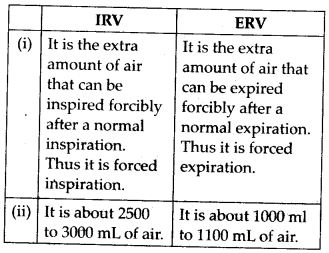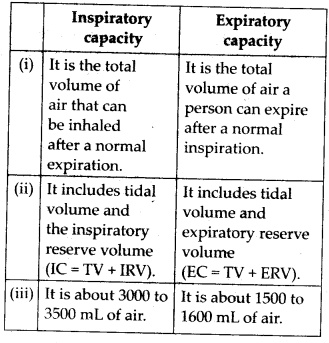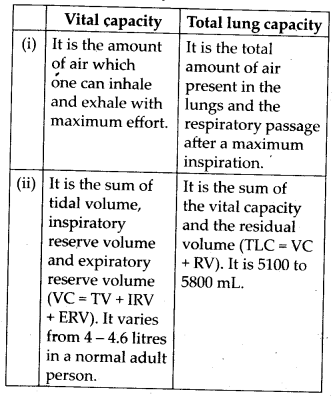NCERT Solutions For Class 11 Biology Breathing and Exchange of Gases
Topics and Subtopics in NCERT Solutions for Class 11 Biology Chapter 17 Breathing and Exchange of Gases :
| Section Name | Topic Name |
| 17 | Breathing and Exchange of Gases |
| 17.1 | Respiratory Organs |
| 17.2 | Mechanism of Breathing |
| 17.3 | Exchange of Gases |
| 17.4 | Transport of Gases |
| 17.5 | Regulation of Respiration |
| 17.6 | Disorders of Respiratory System |
| 17.7 | Summary |
NCERT TEXTBOOK QUESTIONS FROM SOLVED
1. Define vital capacity. What is its significance?
Solution:
Vital capacity is defined as the maximum volume of air a person can breathe in after a forced expiration or the maximum volume of air a person can breathe out after a forced inspiration. It represents the maximum amount of air one can renew in the respiratory system in a single respiration. Thus, greater the vital capacity more is the energy available to the body.
2. State the volume of air remaining in the lungs after a normal breathing.
Solution:
When a person breathes normally, the amount which remains in the lung after normal expiration, is called functional residual capacity. It is the sum of residual volume and the expiratory reserve volume (FRC = RV + ERV). It is about 2100 – 2300 mL of air.
More Resources for CBSE Class 11
- NCERT Solutions
- NCERT Solutions Class 11 Maths
- NCERT Solutions Class 11 Physics
- NCERT Solutions Class 11 Chemistry
- NCERT Solutions Class 11 Biology
- NCERT Solutions Class 11 Hindi
- NCERT Solutions Class 11 English
- NCERT Solutions Class 11 Business Studies
- NCERT Solutions Class 11 Accountancy
- NCERT Solutions Class 11 Psychology
- NCERT Solutions Class 11 Entrepreneurship
- NCERT Solutions Class 11 Indian Economic Development
- NCERT Solutions Class 11 Computer Science
3. Diffusion of gases occurs in the alveolar region only and not in the other parts of respiratory system. Why?
Solution:
For efficient exchange of gases, respi: atory surface must have certain characteristics such as (i) it must be thin, me ist and permeable to respiratory gases (ii) it must have large surface area, (iii) it must be highly vascular. Only alveolar region has these characteristics. Thus, diffusion of gases occurs in this region only.
4. What are the major transport mechanisms for CO
2
? Explain.
Solution:
Nearly 20-25 percent of CO
2
is transported by haemoglobin of RBCs, 70 percent of it is carried as bicarbonate ion in
plasma and about 7 percent of CO
2
is carried in a dissolved state through plasma. CO
2
is carried by haemoglobin as carbamino- haemoglobin. This binding is related to the partial pressure of CO
2
.
5. What will be the p02 and pCO
2
in the atmospheric air compared to those in the alveolar air?
(i) pO
2
lesser, pCO
2
higher
(ii) pO
2
higher, pCO
2
lesser
(iii) pO
2
higher, pCO
2
higher
(iv) pO
2
lesser, pCO
2
lesser
Solution:
(ii) Air that has entered the alveoli through the bronchioles is called alveolar air. It has the same partial pressure of CO
2
and 02 as is in the atmospheric air. Then, there occurs gaseous exchange between the adjacent blood capillaries and the alveoli. CO
2
diffuses from blood into the alveolar air and O
2
diffuses from alveolar air to the blood. As a result, new alveolar air has higher pCO
2
and lesser pO
2
, than the atmospheric air.
6. Explain the process of inspiration under normal conditions.
Solution:
Inspiration is a process by which fresh air enters the lungs. The diaphragm, intercostal muscles and abdominal muscles play an important role. The muscles of the diaphragm and external intercostal muscles are principle muscles of inspiration. Volume of thoracic cavity increases by contraction of diaphragm and external intercostal muscles. During inspiration, relaxation of abdominal muscles also occurs which allows compression of the abdominal organs by diaphragm. Thus, overall volume of the thoracic cavity increases and as a result, there is a decrease of the air pressure in the lungs. The greater pressure outside the body now causes air to flow rapidly into the lungs. The sequence of air flow is.
7. How is respiration regulated?
Solution:
Respiration is under both nervous and chemical regulation.
The respiratory centre in brain is composed of groups of neurons located in the medulla oblongata and pons varolii. The respiratory centre regulates the rate and depth of the breathing.
Dorsal respiratory group of neurons are located in the dorsal portion of the medulla oblongata. This group of neurons mainly causes inspiration.
Ventral group of neurons are located in the ventrolateral part of the medulla oblongata. These can cause either inspiration or expiration.
Pneumotaxic centre is located in the dorsal part of pons varolii. It sends signals to all the neurons of dorsal respiratory group and only to inspiratory neurons of ventral respiratory group. Its job is primarily to limit inspiration. Chemically, respiration is regulated by the large numbers of chemoreceptors located in the carotid bodies and in the aortic bodies. Excess carbon dioxide or hydrogen ions mainly stimulate the respiratory centre of the brain and increases the inspiratory and expiratory-signals to the respiratory muscles. Increased C0
2
lowers the pH resulting in acidosis. The role of oxygen in the regulation of respiratory rhythm is quite insignificant.
8. What is the effect of pCO
2
on oxygen transport?
Solution:
Increase in pCO
2
tension in blood brings rightward shift of the oxygen dissociation curve of haemoglobin thereby decreasing the affinity of haemoglobin for oxygen. This effect is called Bohr’s effect. It plays an important role in the release of oxygen in the tissues.
9. What happens to the respiratory process in a man going up a hill?
Solution:
Rate of breathing will increase in order to supply sufficient oxygen to blood because air in mountainous region is deficient in oxygen.
10. What is the site of gaseous exchange in an insect?
Solution:
Tracheae (Tracheal respiration) is the site of gaseous exchange in an insect. .
11. Define oxygen dissociation curve. Can you suggest any reason for its sigmoidal pattern?
Solution:
The relationship between the partial pressure of oxygen (pO
2
) and percentage saturation of the haemoglobin with oxygen (O
2
)is graphically illustrated by a curve called oxygen haemoglobin dissociation curve (also called oxygen dissociation curve).
The sigmoidal pattern of oxygen haemoglobin dissociation curve is the result of two properties which play significant role in the transport of oxygen. These two properties are:
(i) Minimal loss of oxygen from haemoglobin occurs above p02 of 70-80 mm Hg despite significant changes in tension of oxygen beyond this. This is depicted by relatively flat portion of the curve.
(ii)Any further decline in p02 from 40 mm Hg causes a disproportionately greater release of oxygen from the haemoglobin. It results in the steeper portion of the curve and causes the curve to be sigmoid.
12. Have you heard about hypoxia? Try to gather information about it, and discuss with your friends.
Solution:
Hypoxia is a condition of oxygen shortage in the tissues. It is of two types:
(i) Artificial hypoxia: It results from shortage of oxygen in the air as at high altitude. It causes mountain sickness characterised by breathelessnes, headache, dizziness and bluish tinge on skin.
(ii) Anaemic hypoxia: It results from the reduced oxygen carrying capacity of the blood due to anaemia or carbon monoxide poisoning. In both cases, less haemoglobin is available for carrying 0
2
.
13. Distinguish between
(a) IRV and ERV
(b) Inspiratory capacity and expiratory capacity.
(c) Vital capacity and total lung capacity.
Solution:
(a) Differences between IRV and ERV are as follows:

(b)Differences between inspiratory capacity and expiratory capacity are as follows:

(c) Differences between vital capacity and total lung capacity are as follows:

14. What is tidal volume? Find out the tidal volume (approximate value) for a healthy human in an hour.
Solution:
Tidal volume is the volume of air inspired or expired with each normal breath. This is about 500 mL in an adult person. It is composed of about 350 mL of alveolar volume and about 150 mL of dead space volume. The alveolar volume consists of air that reaches the respiratory surfaces of the alveoli and engages in gas exchange. The dead space volume consists of air that does not reach the respiratory surfaces.
A healthy man can inspire or expire approximately 6000 to 8000 mL of air per minute. Therefore, tidal volume for a healthy human in an hour is 360 – 480 mL of air.